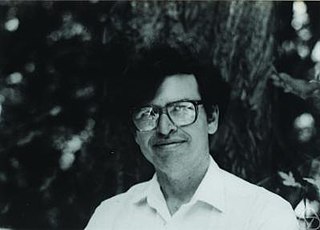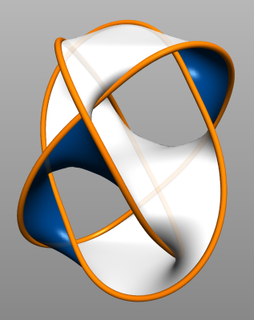
William Paul Thurston was an American mathematician. He was a pioneer in the field of low-dimensional topology. In 1982, he was awarded the Fields Medal for his contributions to the study of 3-manifolds. From 2003 until his death he was a professor of mathematics and computer science at Cornell University.

In knot theory, a figure-eight knot is the unique knot with a crossing number of four. This makes it the knot with the third-smallest possible crossing number, after the unknot and the trefoil knot. The figure-eight knot is a prime knot.

In topology, knot theory is the study of mathematical knots. While inspired by knots which appear in daily life, such as those in shoelaces and rope, a mathematical knot differs in that the ends are joined together so that it cannot be undone, the simplest knot being a ring. In mathematical language, a knot is an embedding of a circle in 3-dimensional Euclidean space, . Two mathematical knots are equivalent if one can be transformed into the other via a deformation of upon itself ; these transformations correspond to manipulations of a knotted string that do not involve cutting the string or passing the string through itself.

In the mathematical field of knot theory, a knot invariant is a quantity defined for each knot which is the same for equivalent knots. The equivalence is often given by ambient isotopy but can be given by homeomorphism. Some invariants are indeed numbers, but invariants can range from the simple, such as a yes/no answer, to those as complex as a homology theory. Research on invariants is not only motivated by the basic problem of distinguishing one knot from another but also to understand fundamental properties of knots and their relations to other branches of mathematics.

In the mathematical area of knot theory, a Reidemeister move is any of three local moves on a link diagram. Kurt Reidemeister (1927) and, independently, James Waddell Alexander and Garland Baird Briggs (1926), demonstrated that two knot diagrams belonging to the same knot, up to planar isotopy, can be related by a sequence of the three Reidemeister moves.

In knot theory, a knot or link diagram is alternating if the crossings alternate under, over, under, over, as one travels along each component of the link. A link is alternating if it has an alternating diagram.
Algorithmic topology, or computational topology, is a subfield of topology with an overlap with areas of computer science, in particular, computational geometry and computational complexity theory.

In mathematics, a Seifert surface is a surface whose boundary is a given knot or link.

In knot theory, the Whitehead link, named for J. H. C. Whitehead, is one of the most basic links.
In mathematics, Khovanov homology is an oriented link invariant that arises as the homology of a chain complex. It may be regarded as a categorification of the Jones polynomial.
Peter B. Shalen is an American mathematician, working primarily in low-dimensional topology. He is the "S" in JSJ decomposition.
Peter Benedict Kronheimer is a British mathematician, known for his work on gauge theory and its applications to 3- and 4-dimensional topology. He is William Caspar Graustein Professor of Mathematics at Harvard University and former chair of the mathematics department.
In mathematics, hyperbolic Dehn surgery is an operation by which one can obtain further hyperbolic 3-manifolds from a given cusped hyperbolic 3-manifold. Hyperbolic Dehn surgery exists only in dimension three and is one which distinguishes hyperbolic geometry in three dimensions from other dimensions.

In mathematics, the unknotting problem is the problem of algorithmically recognizing the unknot, given some representation of a knot, e.g., a knot diagram. There are several types of unknotting algorithms. A major unresolved challenge is to determine if the problem admits a polynomial time algorithm; that is, whether the problem lies in the complexity class P.

William Bernard Raymond Lickorish is a mathematician. He is emeritus professor of geometric topology in the Department of Pure Mathematics and Mathematical Statistics, University of Cambridge, and also an emeritus fellow of Pembroke College, Cambridge. His research interests include topology and knot theory. He was one of the discoverers of the HOMFLY polynomial invariant of links, and proved the Lickorish-Wallace theorem which states that all closed orientable 3-manifolds can be obtained by Dehn surgery on a link.
In mathematics, the 2π theorem of Gromov and Thurston states a sufficient condition for Dehn filling on a cusped hyperbolic 3-manifold to result in a negatively curved 3-manifold.
In the mathematical subject of group theory, small cancellation theory studies groups given by group presentations satisfying small cancellation conditions, that is where defining relations have "small overlaps" with each other. Small cancellation conditions imply algebraic, geometric and algorithmic properties of the group. Finitely presented groups satisfying sufficiently strong small cancellation conditions are word hyperbolic and have word problem solvable by Dehn's algorithm. Small cancellation methods are also used for constructing Tarski monsters, and for solutions of Burnside's problem.
In the mathematical subject of geometric group theory, a Dehn function, named after Max Dehn, is an optimal function associated to a finite group presentation which bounds the area of a relation in that group in terms of the length of that relation. The growth type of the Dehn function is a quasi-isometry invariant of a finitely presented group. The Dehn function of a finitely presented group is also closely connected with non-deterministic algorithmic complexity of the word problem in groups. In particular, a finitely presented group has solvable word problem if and only if the Dehn function for a finite presentation of this group is recursive. The notion of a Dehn function is motivated by isoperimetric problems in geometry, such as the classic isoperimetric inequality for the Euclidean plane and, more generally, the notion of a filling area function that estimates the area of a minimal surface in a Riemannian manifold in terms of the length of the boundary curve of that surface.

Marc Edward Culler is an American mathematician who works in geometric group theory and low-dimensional topology. A native Californian, Culler did his undergraduate work at the University of California at Santa Barbara and his graduate work at Berkeley where he graduated in 1978. He is now at the University of Illinois at Chicago. Culler is the son of Glen Jacob Culler who was an important early innovator in the development of the Internet.
Martin George Scharlemann is an American topologist who is a professor at the University of California, Santa Barbara. He obtained his Ph.D. from the University of California, Berkeley under the guidance of Robion Kirby in 1974.











